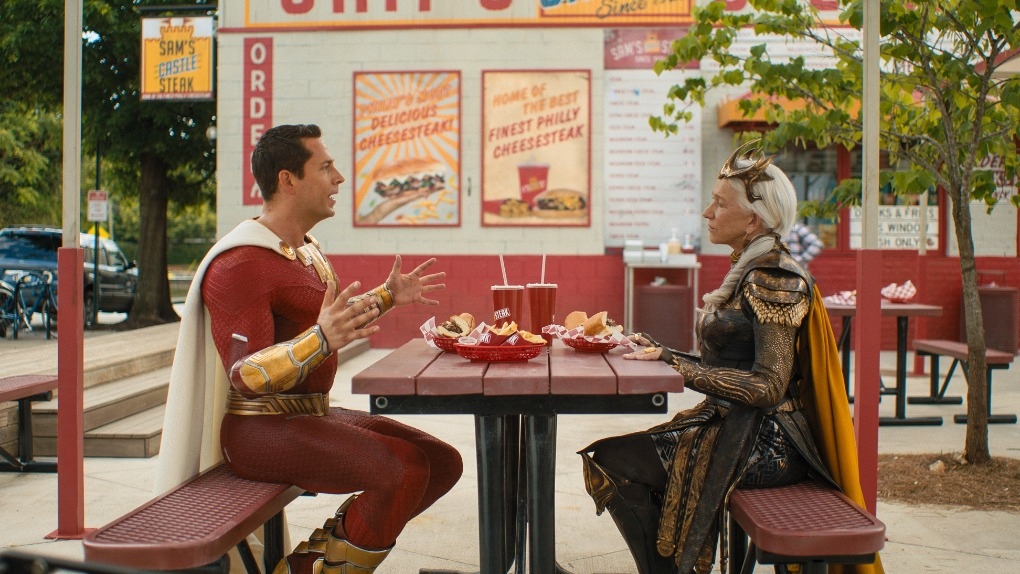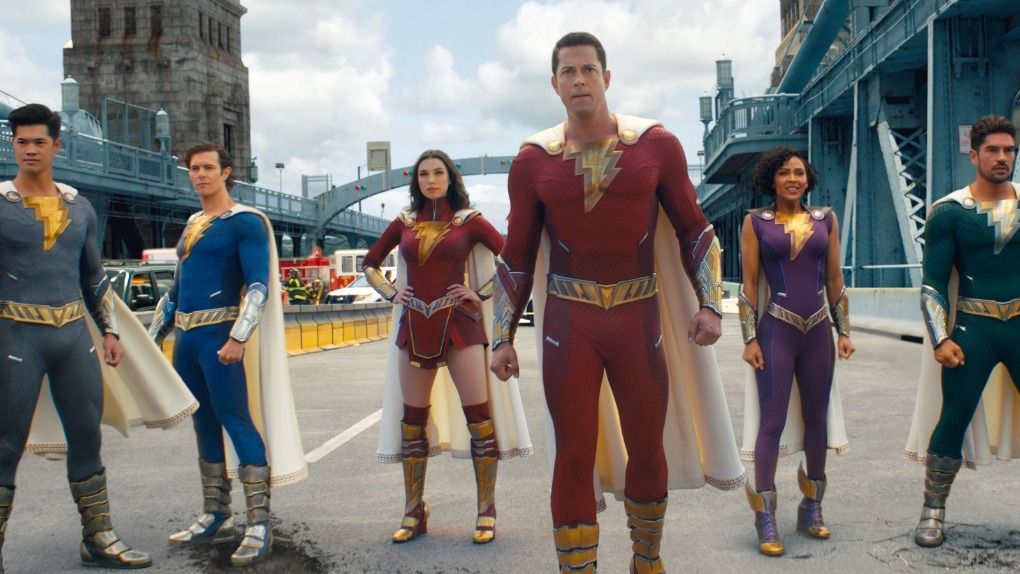SHAZAM!: FURY OF THE GODS: 3 STARS

In the new film, “Shazam!: Fury of the Gods,” set two years after the events of the first movie, Billy still grapples with his superhero alter ego (Zachary Levi). “I’m an idiot,” he says. “I don’t deserve these powers, if I’m being honest. Like, what am I even contributing? There’s already a superhero with a red suit with a lightening bolt on it. Aquaman is literally huge, and he’s so manly. And Batman, he’s so cool. I feel like a fraud.”
This new adventure sees Batson, and his foster siblings, who also transform into superheroes by saying the magic word “Shazam!,” pitted against their most ferocious foe yet, the Daughters of Atlas.
“We are at war,” says Hespera (Helen Mirren). “We will annihilate everything. The champions of this realm can do nothing to stop us.”
The Daughters of Atlas want to strip the Shazam gang of their powers but as they do that the fate of the world hangs in the balance. “You are very menacing,” Shazam says to Hespera. “I just want you to know that.”
At its heart “Shazam!: Fury of the Gods” is a coming-of-age story. Billy begins the movie insecure, a victim of imposter syndrome. Unfortunately, as his confidence grows, so does the movie’s tendency to clutter up the screen with busy CGI, heaping helpings of mythology and not-so-subtle product placement. (They even manage to find a way to work in the Skittles “taste the rainbow” slogan.)
The best elements of the first film are present. The focus on family—finding your logical, if not biological family—the humour and Levy’s manchild performance as the title character, provide the film’s heart, but the effort to make the sequel bigger-and-better overshadow the more organic, pleasing parts of the story.
It is a blast to see Helen Mirren channel her inner Shakespearean villain as Hespera, and some of the Ray Harryhausen-inspired creatures have a cool, “Famous Monsters of Filmland” retro appeal but, in general, when it comes to “Shazam!: Fury of the Gods,” bigger is not better.
BOSTON STRANGLER: 3 ½ STARS
Disney+ wades into the true crime pool with a retelling of one of the most notorious serial killers of the 1960s.
From June 14, 1962 to January 4, 1964, thirteen single women, between the ages of 19 and 85, were sexually assaulted in their apartments before being strangled with articles of clothing.
Dubbed the “Silk Stocking Murders,” the case left police scrambling until reporters Loretta McLaughlin (Kiera Knightly) and Jean Cole (Carrie Coon) connected the murders and dubbed the killer the Boston Strangler. “The city is, for some, glamorous, stimulating, prosperous,” says a radio reporter. “Only recently has it become dangerous.”
When we first meet McLaughlin she is an ambitious reporter for the Record-American newspaper stuck on the lifestyle desk. Her pitches for hard news stories, including one on three elderly victims of a mysterious killer, are brushed aside.
“I don’t see the interest,” says editor Jack MacLaine (Chris Cooper). “These are nobodies.”
When McLaughlin offers to work on the story in her spare time, MacLaine relents, but adds, “You’re still on the lifestyle desk.”
As the mysterious murderer continues to strike, McLaughlin recruits Cole, one of the few female reporters not working on the lifestyle desk, to expand the investigation. Together they fight against the blue wall of police silence, the sexism of the newsroom and the very real threat of violence at the hand of the man they are helping to expose.
“Boston Strangler” is a period piece that works on a couple of levels. It is, first and foremost, a journalism procedural along the lines of “She Said” or “Spotlight,” following the reporters and their investigation.
Unlike “The Boston Strangler,” the 1968 Tony Curtis big screen version of the story, which focused on the efforts of the police, this is a story of finding the story. McLaughlin and Cole methodically build the case that these murders are connected, and that they are likely the work of one person. Despite very real threats to their safety as they hone in on one suspect, they are driven by the door knocking, boots-on-the-ground passion for the work.
Just as important is the portrait of workplace culture it paints in regards to women in the newsroom. The era’s rampant sexism, inside the newsroom and out, suggested the two women not only lacked the skills to cover the story but that they were emotionally unequipped to be involved with the case. The real-life McLaughlin and Cole were pioneers at a time when most women in newsrooms were relegated to soft news, advice columns or fetching coffee for their editors.
In fine performances, Knightly and Coon both embody the tenacity it took to smash the glass ceiling and break the Boston Strangler story. McLaughlin kicks through the gender norms of the 1960s, shaping the future she wants for herself, professionally and personally. Coon, playing a character who had worked in newsrooms since the age of 18, is spirited and funny with a razor-sharp wit.
Although there are several upsetting scenes and descriptions of the victims, the movie wisely put its focus on McLaughlin and Cole, rather than the grisly details of the crimes. Unlike the awkwardly titled “Dahmer – Monster: The Jeffrey Dahmer Story,” “Boston Strangler” doesn’t feel exploitive in its retelling of the sensational story.
Given the popularity of true crime, the murder aspect of “Boston Strangler” is the hook, but the story is deepened by its portrait of the importance of journalism to uncover the truth, and the intrepid reporters who do the work, despite the consequences.
BROTHER: 3 ½ STARS
In “Brother,” a new coming of age story from “The Wire” director Clement Virgo, now playing in theatres, weaves three timelines together to form a vivid portrait of memory, regret and grief.
Based on the novel of the same name by David Chariandy, and adapted by Virgo, “Brother” is the story of Francis (Aaron Pierre) and younger sibling Michael (Lamar Johnson), the sons of Jamaican immigrants, growing up in Scarborough, Ontario. The athletic Francis, who harbors dreams of becoming a music producer, exudes confidence. He is Michael’s surrogate father and, despite quitting school mid-term, is his role model and guardian angel.
But even with Francis on his side, Michael is overwhelmed by police overreach and the gang violence gripping the neighborhood. Random shootings are a regular event and once, a stray bullet even pierces the wall of a nearby apartment, killing an innocent child.
On their way to adulthood, the brothers are bonded by family, but choose different paths.
The parallel stories of “Brother,” told on a broken timeline, are skillfully handled by Virgo. He interlaces the various timeframes to create a vivid portrait of the lives of these two young men and the pressures that formed and informed their personalities.
As adults the two lead characters are brought to vivid life by British actor Aaron Pierre, who reveals real vulnerability as the formidable Francis, and Lamar Johnson as younger brother Michael, who struggles to live in the long shadow cast by his older brother.
It is the story of their struggle to live up to expectations, but more importantly, it is about the toll of the struggle. Disappointment hangs over Francis’s character, and as he becomes more and more unpredictable, Pierre skillfully displays the ways that his risk taking is the symptom of dashed dreams and it is heartbreaking.
Virgo’s supple, elegant filmmaking reinforces the film’s central themes by creating a richly textured world for the characters to inhabit. The streets that represent a looming danger to Michael are beautifully shot, at once suburban stark and yet poetic. It is that juxtaposition that gives “Brother” its layered, complex thematic feel.
“Brother” features fine performances, a killer soundtrack that ranges from Nina Simone singing Jaques Brel to reggae to hip hop, and combines them to tell an emotionally arresting story that is both thoughtful and tangible.
RICEBOY SLEEPS: 3 STARS
“Riceboy Sleeps,” a new drama from Vancouver director Anthony Shim, and now playing in theatres, is a meditative study in the immigrant experience in Canada through the lens of a mother and son relationship.
Set in the 1990s, Choi Seung-yoon is So-young, a single-mother to Dong-Hyun (as a child played by Dohyun Noel Hwang, later, as a teen by Ethan Hwang), who moved to Canada from Korea following the death of her husband. Once in Canada, the better life she hoped for seems just out of reach.
At her factory job So-young faces discrimination and, at school Dong-hyun is teased because his lunches are different than the sandwiches everyone has in their lunch boxes. His teacher even anglicizes his name to David because she can’t properly pronounce Dong-hyun.
Life isn’t easy for them. Dong-hyun, who, trying to assimilate to his new home, dyes his hair blonde and wears blue contacts, is suspended from school for fighting, and turns to drugs.
Gradually mother and son drift apart, but when So-young receives life-changing news, they attempt to reconnect with one another and with their heritage on a trip to Korea.
“Riceboy Sleeps” occasionally dips into melodrama, but is remarkably effective in its portrayal of the isolation and frustration that envelopes So-young and Dong-hyun’s new life. It’s in the details, the small (and sometimes not so small) behaviors, that define their interactions with many co-workers, doctors and even Dong-hyun’s teachers. Director Shim smartly visualizes the cultural claustrophobia with a boxy aspect ratio that doesn’t open up until the Korean sequences.
The natural performances are particularly effective in the film’s intimate moments. A scene where So-young struggles to use a Korean-English dictionary understand her cancer diagnosis is as frustrating and tragic as it is heartbreaking.
Ultimately, it is the film’s central relationship, the mother/son bond, that gives “Riceboy Sleeps” its poignancy.






More Stories
B.C. civil lawsuit against Sex Pistols guitarist alleges 1980 sexual assault | CBC News
Montreal actress calls Weinstein ruling ‘discouraging’ but not surprising
Estate of Tupac Shakur sends cease-and-desist letter to Drake over AI vocals